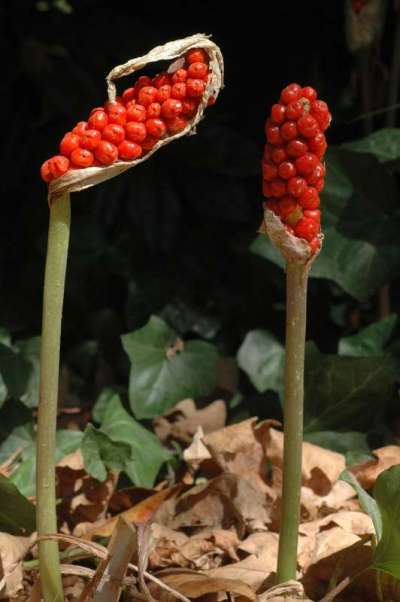
Italian Arum (Arum italicum) – Class C Non-Regulated Noxious Weed in King County, Washington
I first learned to fear Italian arum in the late 1990’s. Botanist Doug Ewing, then manager of the University of Washington Botany Greenhouse, alarmed me with scary tales of his battles with Italian arum in the gardens behind the greenhouse where it had taken hold. No matter what he threw at it, the plant kept coming back and even seemed to thrive on his efforts to eradicate it. Herbicides wouldn’t kill the tubers, digging it out seemed to make it worse, and it just kept spreading to new places. Picture the broom in the Sorcerer’s Apprentice story.
The crystalline toxins in the plant kept it from being eaten by anything, even slugs, and created problems for anyone trying to remove it by hand. According to the Washington State Weed Board written findings, Italian arum is poisonous because it contains large quantities of needle-shaped crystals of calcium oxalate. The crystals can irritate the skin, mouth, tongue and throat and result in throat swelling, breathing difficulties, burning pain and stomach upset. It’s no wonder animals don’t eat this plant!
Doug assured me the species had more than earned a place on the state noxious weed list, but he was ahead of his time. It took 15 more years as others began to report the same experiences to state noxious weed experts, but Italian arum was indeed finally added to the Washington State Noxious Weed List in 2015. Now that the plant is an official noxious weed, we are working even harder to get the word out to everyone to watch out for this plant that caused such a nightmare for botanist Doug Ewing all those years ago. In fact, recently at the Northwest Flower and Garden Show, I heard from many people how they were struggling to get rid of Italian arum or seeing it spread from where it just showed up one day.
Italian arum, native to parts of Europe, Asia and northern Africa, is similar to North America’s native skunk cabbage species and resembles them in appearance (and odor!). The leaves are large and waxy and the flower structure has a central spike surrounded by a large hood-like structure. This type of floral arrangement has the cool botanical name “spathe and spadix”. Like skunk cabbage, Italian arum can also be found in moist forests and along streams, and can form extensive stands.

What stands out with this plant for most people is the marbled look of the large, shiny arrow-shaped leaves and the striking spikes of plump, orange-red berries. The leaves tend to die back in the heat of the summer so the spikes of berries can appear as if out of nowhere. The attractive red berries are consumed by birds that spread the plant to new areas. Water may also move berries and seeds around when the plant grows in areas that flood.
Underground, the plant produces a large sturdy tuber and zillions of daughter tubers than tend to break off when the plant is dug up. This of course ensures the continuation of the species after the parent plant dies off (or is dug up by some well-intentioned gardener regretting their decision to plant it in the first place).
Although Italian arum is on the state noxious weed list, it hasn’t been added to the state’s quarantine list (as of the writing of this article) so it is still legal to buy and sell it in Washington. People may choose to control it but they don’t have to according to the state noxious weed law unless it is selected as regulated in their county. The main goal for listing this species as a noxious weed is to increase the education about its invasiveness and toxicity and to make it easier for counties and private landowners to work on controlling it. More information about the noxious weed laws and list can be found on our lists and laws web page.
Unfortunately, controlling Italian arum is proving to be as big a challenge as Doug Ewing discovered so many years ago. Digging it out or spraying it with herbicide are both just temporary measures because of the difficulty in eliminating all the tubers. Burning it may be satisfying but is equally short-term. Covering with tarping or sheet mulch may eventually work, but it isn’t known how long the covering needs to be in place (several years of tarping did not control it for one person). As with all invasive plants, prevention is the only sure way to avoid problems. Don’t plant Italian arum in the first place and watch for yard waste dumping on your property where it might get introduced. If it is already present, make sure you don’t move the contaminated soil around. Containment might be the only realistic goal for established populations, although I always hold out hope that with enough persistence any plant can be eradicated.
Because Italian arum is a non-regulated noxious weed in King County, we aren’t specifically tracking locations. However, it would be helpful to know where the plant has established, especially in natural areas where it could be a big problem for habitat and native species. Also, if you discover the secret to eradicating Italian arum, be sure to share that information. You will be doing us all a huge favor!
For more information about Italian arum, visit the Washington State Noxious Weed Board website. For more information about noxious weeds in King County or to contact us, visit our website kingcounty.gov/weeds.